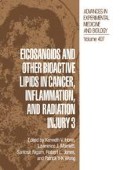Abstract
Pickles (1967) proposed that up to four different prostanoid types existed. Coleman et al. (1984) developed a working classification for the prostanoid receptors and since then there has been some debate concerning heterogeneity of each receptor. Following on from these studies, extensive work has led to systematic prostanoid receptor classification. The present prostanoid receptor classification is a simple systematic working hypothesis whereby each of the natural prostanoids has its own receptor termed a P receptor where it is at least ten times more potent than any of the other natural prostanoids. Thus the prostaglandin E2 (PGE2)-sensitive receptors are termed the EP-receptors, PGF2α FP-receptors, PGD2, DP-receptors, PGI2, IP receptors and the thromboxane A2 (TXA2)-sensitive receptors, TP-receptors (Kennedy et al., 1982). The thromboxane receptor (TP) has been shown to mediate constriction of airway and vascular smooth muscle as well as platelet aggregation but discussion has failed to resolve the number of receptors involved.
Access this chapter
Tax calculation will be finalised at checkout
Purchases are for personal use only
Preview
Unable to display preview. Download preview PDF.
References
Arunlakshana, O. & Schild, H.O. (1959). Some quantitative uses of drug antagonists. Br. J. Pharmacol Chemother. 14, 48–58.
Aultura, G.P. & Karim S.M.M. (1972). Effects of prostaglandins A1, A2, B1, B3, E2, and F2α on human umbilical cord vessels. Prostaglandins, 8, 411–416.
Burk, R.M., Gac, T.S., Krauss, A.H., Woodward, D.W. (1994). Synthesis of a novel series of 3-oxo-2,4-dioxo-bi-cyclo [3.2.1] octanes. Pharmacological evidence for two thromboxane receptor subtypes. In Abstracts for the 9th international conference on prostaglandins and related substances, p. 43. Fondazione Giovanni Lorenzini.
Clayton, J.K., Marshall, K., Sangha, R., Kennedy, F. & Senior, J. (1994). Comparison of uterine thromboxane receptors. In Abstracts for the 9th international conference on prostaglandins and related substances, p. 110. Fondazione Giovanni Lorenzini.
Coleman, R.A., Humphrey, P.P.A., Kennedy, I., Lumley, P. (1984). Prostanoid receptors-The development of a working classification. TIPS, 303-306
Davingdon, J., Lorenz, R.R. & Shepherd, J.T. (1965). Response of human umbilical artery to changes in transmural pressure. Am. J. Physiol 209, 51–59.
Hillier, K. & Karim, S.M.M. (1968). Effects of prostaglandins E1, E2, F1α, F2α on isolated human umbilical and placental vessels. Br J. Obs. Gynaec., 180, 363–385.
Kennedy, I., Coleman, R.A., Humphrey, P.P.A., Levy, G.P. & Lumley, P. (1982). Studies on the characterisation of prostanoid receptors: A proposed classification. Prostaglandins, 24, 667–689.
Krauss, A-H. P., Woodward, D.F., Gibson, L.L., Protzman, C.E., Williams, L.S., Burk, R.M., Gac, T.S., Roof, M.B., Abbas, F., Marshall, K. and Senior, J. (1996). Evidence for human thromboxane receptor heterogeneity using a novel series of 9, 11,-cyclic carbonate derivatives of prostaglandin F2α. Br. J. Pharmacol., (in press).
Lumley, P., Humphrey, P.P.A., Kennedy, I. & Coleman, R.A. (1982). Comparison of the potencies of some prostaglandins as vasodilators in three vascular beds of the anaesthetised dog. Eur. J. Phrmacol., 81, 421–430.
Mais, D.E., Deholl, D., Sightler, H., Halushka, P.V. (1988). Different pharmacological activities for 13-azapinane thromboxane A2 analogs in platelets and blood vessels. Eur. J. Pharmacol 148, 309–315.
McKennif, M.G., Norman, P., Cuthbert, N.J. & Gardiner, P.J. (1991). BAY u3405, a potent and selective thromboxane A2 receptor antagonist on airway smooth muscle in vitro. Br. J. Pharmacol, 104, 579–590.
Masuda, A., Mais, D.E., Oatis, R.A., & Halushka. P.A. (1991). Platelet and vascular thromboxane A2/prostaglandin H2 receptors: Evidence for different subclasses in the rat. Biochem. Pharmacol, 42, 537–544.
Ogletree, M.L., Harris, D.N., Greenberg, R., Haslanger, M.F. & Nakane, M. (1985). Pharmacological actions of SQ 29548, a novel selective thromboxane antagonist. J. Pharmacol. Exp. Then, 234, 435–441.
Pickles, V.R. (1967). The myometrial action of six prostaglandins: Consideration of a Receptor Hypothesis: The Nobel Symposium, Vol 2: Prostaglandins ed. Bergstrom, S. & Samuelsson, B. pp. 79-83. Stockholm: Almquist and Wiksell.
Piper, P.J. & Vane, J.R. (1971). The release of prostaglandins from lung and other tissues. Annals. N. Y. Acad. Sci., 180, 363–385.
Senior, J., Marshall, K., Sangha, R., Baxter, G.S. & Clayton, J.K. (1991). In vitro characterization of prostanoid EP-receptors in the non-pregnant human myometrium. Br. J. Pharmacol, 102, 747–753.
Tymkewcz, P.M., Jones, R.L., Wilson, N.M. & Marr, C.G. (1991). Heterogeneity of thromboxane A2 (TP-) receptors: Evidence from antagonist potency measurements. Br. J. Pharmacol, 102, 607–614.
von Euler, U.S. (1938). Action of adrenaline, acetylcholine and other substances on nerve free vessels (human placenta). J. Physiol. 93, 129–143.
Wulf, H. (1964). The oxygen and carbon dioxide tension gradients in the human placenta at term. Am. J. Obs. Gynaec. 88(1), 38–44.
Author information
Authors and Affiliations
Editor information
Editors and Affiliations
Rights and permissions
Copyright information
© 1997 Springer Science+Business Media New York
About this chapter
Cite this chapter
Abbas, F. et al. (1997). A Comparative Study of Thromboxane (TP) Receptor Mimetics and Antagonists on Isolated Human Umbilical Artery and Myometrium. In: Honn, K.V., Marnett, L.J., Nigam, S., Jones, R.L., Wong, P.YK. (eds) Eicosanoids and other Bioactive Lipids in Cancer, Inflammation, and Radiation Injury 3. Advances in Experimental Medicine and Biology, vol 407. Springer, Boston, MA. https://doi.org/10.1007/978-1-4899-1813-0_33
Download citation
DOI: https://doi.org/10.1007/978-1-4899-1813-0_33
Publisher Name: Springer, Boston, MA
Print ISBN: 978-1-4899-1815-4
Online ISBN: 978-1-4899-1813-0
eBook Packages: Springer Book Archive

